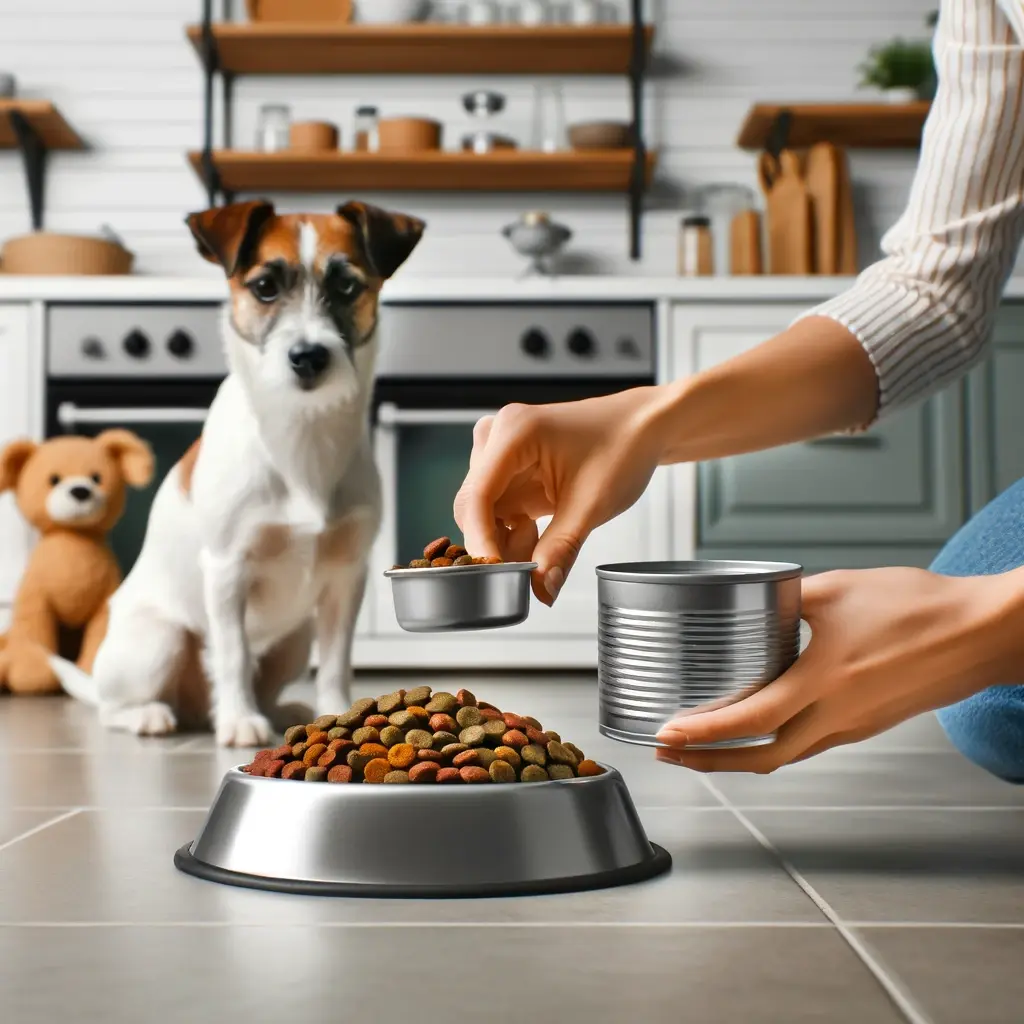Here’s a breakdown of how to determine the right amount of canned food for your dog, plus why it’s important:
Canned Food for Dogs
- Benefits: Often higher in protein, moisture content, and palatability. Good for hydration, picky eaters, and dogs with dental issues.
- Considerations: Can be more expensive than kibble, and easier to overfeed due to the higher water content.
Why the Right Amount Matters
- Health: Too little food leads to nutrient deficiencies, too much leads to obesity and related issues (joint problems, heart disease, etc.).
- Balancing Act: The right amount ensures your dog gets what they need for optimal health and energy levels.
How Much Canned Food to Feed Your Dog
Unfortunately, there’s no one-size-fits-all answer. The ideal amount depends on your dog’s:
- Age:
- Puppies: Need more frequent, calorie-dense meals to support growth.
- Adults: Typically 2-3 meals a day
- Seniors: May need fewer calories to prevent weight gain.
- Weight: This is a major factor. A vet can help determine your dog’s ideal weight and the corresponding food intake.
- Size: Larger breeds generally eat more than smaller breeds.
- Activity Level: Highly active dogs burn more calories and need more food than couch potatoes.
Rough Guidelines (Always Consult Your Vet)
- Puppy: Around one 3oz can per 3-3.5 lbs of body weight daily, divided into several meals.
- Adult Dog: Approximately one 10oz can per 10.5 – 12.5 lbs of body weight daily, divided into meals.
Important Notes
- Start with Feeding Guides: Most canned foods have recommended amounts on the label. Use this as a starting point and adjust based on your dog.
- Monitor Weight: Weigh your dog regularly. If they’re gaining or losing unexpectedly, adjust their food intake accordingly.
- Vet is Your Best Resource: They can personalize a feeding plan and spot potential health problems early on.
Key Takeaways
- Canned Food Can Be a Healthy Choice: It offers benefits, but portion control is key.
- Individual Needs Matter: There’s no universal feeding amount. Your dog’s unique factors determine the right quantity.
- Don’t Guess, Consult a Vet: Get expert guidance for accurate amounts and keep your furry friend thriving.
Canned Food VS Dry Food for Dogs
Although canned and dry feeds must satisfy the very same nutritional status, they will both give appropriate nutrition,
but for particular dogs and conditions, tinned or dry could be the better option. Canned diets are often more hard to maintain than dry diets since you are buying a can that contains 75-85% water.
Why Do Dog Owners Choose Canned Food for Their Canine Friends?
As per a survey, it was found that nowadays, dog owners are choosing canned food for their canine friends more than dry pet foods, as they discovered that canned food is beneficial in many ways. The benefits of choosing canned foods are discussed below.
Rich in Protein
Canned foods have higher protein constituents than the other dry foods available on the market.
A recent survey has proved this fact by comparing the dry and canned wet food of the same brand, which shows that the protein percentage of dry food seems a lot high due to the less moisture,
but when the wet canned food is converted into a dry matter basis the protein percentage becomes even higher than the dry one.
High Moisture Content
The high moisture content of canned food is the most probable reason behind owners’ preference.
This is because when a dog suffers from dehydration and refuses to drink water, feeding this canned food with a high moisture content can help the dog battle with the discomforts of dehydration by slightly increasing the water level in the body.
The Soft Consistency of the Food
When a dog becomes older, he might get difficulties in chewing the hard, dry food as at the older stage, the teeth lose their calcium and start to fall, due to which the dog loses its capacity to chew.
Some dogs suffering from periodontal diseases also find it difficult to chew the hard, dry foods. This is why the soft consistency of canned dog foods is preferred.
Easy Digestion
Canned foods are designed in such a way that they can provide easy digestion to the canine consuming them. Its design is smooth, and thus the canine doesn’t have to chew it well to break it down into smaller pieces, making it easier to digest.
Less Expensive
While Compared to the other dry food products for dogs available in the market, canned foods are found at a very cheaper rate, 50 % less than the frozen ones and 20 % less than the fresh ones. This is one of the most significant reasons why canned food is preferred over other products.
Why Does the Right Amount of Canned Food Matter?
The amount of food you will give your dog and the nutrients and proteins present in it will decide your dog’s health.
Just like humans, food is the only means by which the body gets its essential nutrients for the smooth regulation of necessary internal body movements like metabolic activities, blood flow, and many others to maintain the dog’s proper health.
Now, as you have chosen canned food as the proper food for your dog, feeding it in the right amount is very necessary because feeding less food will make your dog lack the essential nutrients of the body. Due to this, your dog may even experience deadly nutritional deficiencies.
Along with this feeding, a lesser amount of food to the canine can cause many health issues to the furry friend like obesity, laboured breathing, osteoarthritis, skin disorders, congestive heart failure, and many other issues which can be life-threatening for your dog. So to protect your dog from these deadly health conditions, the right amount of canned food matters.
How Much Canned Food to Feed a Dog?
When coming to the question of how much-canned food a dog needs, this question can’t be answered exactly because dogs of different breeds have their type of needs, and it is almost impossible to determine how much food a dog of a particular breed needs as it can also differ based on their activity level.
As much as the dog will play, the pet will need more food to generate the energy in its body again. Also, dogs differ in size, appetites, health levels, and many other factors due to which the required food amount can vary.
Now we are going to discuss some of the factors influencing the amount of food required for a dog to maintain its proper health to give you an approximate idea of how much you should feed your canine friend below.
Age
The age of your pet has a directly proportional relationship to the amount of food required by your canine friend’s body,
and This is because when the doggy is at a younger age, it is overactive and keeps on playing the entire day which it needs some highly proteinaceous food in quite a large amount to regenerate the energy released from its body.
Whereas the old dogs don’t require much food for their survival as the latter don’t remain that active due to which the energy loss from the body becomes less; thus a less amount of proteinaceous food is required just to fulfil the basic needs of the bodily movements.
As veterinarians suggest, a puppy must get one 3 oz per three to three and a half pounds of body weight daily by dividing it into two to three meals.
This will be enough for properly maintaining the pup’s health, whereas an older dog should get one 10 oz per ten and a half & twelve and a half pounds of body weight daily by getting divided into two to three meals.
Weight of the Dog
It is the most significant factor influencing the required amount of canned food for a dog. The weight of the dog’s body will decide how much the pet needs. If a dog is very lightweight, then the owner must feed him three to four times a day to give the dog a proper weight the body.
If the dog is overweight, then feeding the dog a bit lower amount is necessary as this will help the dog retain its perfect weight,
whereas if a dog is of medium weight, then two to three meals per day are enough. Maintaining the dog’s weight is necessary because improper weight can cause an imbalance in the metabolic activities of the canine friend.
The amount of food that should be provided is as same as the puppy’s requirement mentioned above, and it can be decreased to a bit in the case of overweight dogs.
Size of the Dog
The dog’s size also plays a major role in the food required by the canine. The large the dog is, the more food it requires.
The smaller dogs are more liable to a disease named hypoglycemia which requires a good amount of calories, due to which a perfect amount of feeding is necessary. You can get an approximation by comparing the food intake of a chihuahua and a great day.
The Activity Level of the Dog
The first thing you have to notice in this case is that we are not taking the activity level based on age.
The dogs belonging to the same dog breeds, even if they don’t possess any age gap, may differ in their activity levels, and the more active the dog will be, the more food he would require for a proper balance of its healthy immune system.
Whereas if a dog is less active, then the amount of energy released from the body will be lesser; thus, a less amount of food is required.
All the above-discussed steps are the factors depending on which you can feed the correct proportion of food to your canine friend.
Now it is suggested that visiting a vet can clarify your doubts even more regarding the matter as the vet will do the needed tests on the dog to determine the deficiency of protein and suggest how much you should feed your dog.


